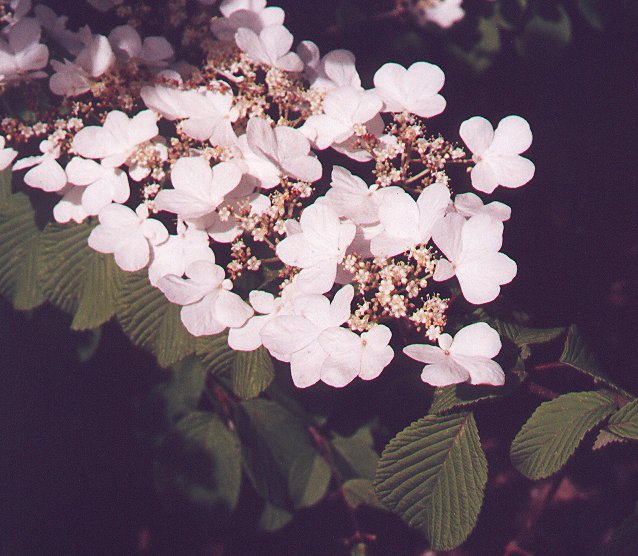Viburnum plicatum Thunb.
Japanese Snowball

Introduced
CC = n/a
CW =
MOC = 1
© DETenaglia
Viburnum plicatum Thunb.Japanese Snowball | |
 |
Introduced CC = n/a CW = MOC = 1 |
© DETenaglia |
|
Family - Caprifoliaceae Stems - Woody, single or more commonly multiple from base, to +/-3m tall, branching. Twigs stellate pubescent. New seasons growth dense stellate pubescent.
Leaves - Opposite, petiolate, serrate-dentate to crenate-serrate, elliptic to ovate or orbicular, acute to abruptly acuminate at apex, stellate pubescent above, densely stellate pubescent below, to +/-10cm long, +/-8cm broad. Petiole +/-3cm long, stellate pubescent, reddish.
Inflorescence - Multiple flat-topped umbellate cymes secund on branches, terminal on new seasons growth. Peduncles to 4cm long, dense stellate pubescent. Flowers - Outer flowers large, white, sterile, 5 lobed, zygomorphic, to -3cm broad. Inner flowers perfect, 5-lobed, whitish, to 5mm broad. Corolla lobes glabrous. Stamens 5, alternating with corolla lobes, adnate at base of corolla tube, exserted. Filaments to -2mm long, white, glabrous. Anthers .5mm long, yellow. Ovary inferior. Calyx tube 1mm long, 5-lobed. Lobes whitish-green, glabrous.
Fruits - 7mm long, elliptic to subglobose, red at first and maturing to black, single-seeded, drupes. Flowering - May - July. Habitat - Cultivated. Origin - Native to Asia. Other info. - This is a heavily cultivated species with many varieties. I believe the plant pictured above is var. tomentosum. The plant is one of the most showy of all the shrubs and is considered the most desirable of the genus for cultivation. It will set fruit if plants are in close proximity with one another. Photographs taken at the Kansas City Zoo, 5-2-99 and 5-15-00. |